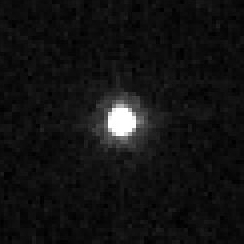471143 Dziewanna (provisional designation 2010 EK139) is a trans-Neptunian object in the scattered disc, orbiting the Sun in the outermost region of the Solar System.
 Dziewanna imaged by the Hubble Space Telescope in 2012 | |
| Discovery [1][2] | |
|---|---|
| Discovered by | A. Udalski S. S. Sheppard M. Kubiak C. Trujillo |
| Discovery site | Las Campanas Obs. |
| Discovery date | 13 March 2010 |
| Designations | |
| (471143) Dziewanna | |
| Pronunciation | /dʒiːˈwɑːnə/,[citation needed] Polish: [d͡ʑɛˈvanna] |
Named after | Devana (Dziewanna) (Slavic goddess)[1] |
| 2010 EK139 | |
| TNO [3] · SDO · 2:7 [4] | |
| Adjectives | Dziewannian |
| Orbital characteristics [3] | |
| Epoch 23 March 2018 (JD 2458200.5) | |
| Uncertainty parameter 3 | |
| Observation arc | 13.16 yr (4,808 d) |
| Aphelion | 108.54 AU |
| Perihelion | 32.551 AU |
| 70.544 AU | |
| Eccentricity | 0.5386 |
| 592.51 yr (216,416 d) | |
| 347.58° | |
| 0° 0m 6.12s / day | |
| Inclination | 29.444° |
| 346.15° | |
| ≈ 22 October 2038[5] ±1 days | |
| 284.25° | |
| Known satellites | none[6] |
| Physical characteristics | |
Mean diameter | >504 km (occultation)[7] 470+35 −10 km[6] 697 km[8] |
| 7.07±0.05[9] | |
| 0.10 (assumed)[8] 0.25+0.02 −0.05[6] | |
| 19.6 (R)[4] 19.9[10] | |
| 3.8±0.1[6] 3.89±0.04 (S)[9] 3.9[1][3] | |
Dziewanna was discovered on 13 March 2010 by astronomers Andrzej Udalski, Scott Sheppard, Marcin Kubiak and Chad Trujillo at the Las Campanas Observatory in Chile.[1] Based on its absolute magnitude and assumed albedo, it is estimated to have a diameter of approximately 470 kilometers.[6] It was named after Devana (Polish form: Dziewanna), a Slavic goddess of the wilderness, forests and the hunt,[1] in honor of the fact that it was discovered during the Polish OGLE project of Warsaw University, which was led by Udalski.[11]
Distance


Dziewanna orbits the Sun at a distance of 32.6 to 108.3 AU once every 591 years and 4 months (215,992 days). Its orbit has an eccentricity of 0.54 and an inclination of 29° with respect to the ecliptic.[3]It is currently 39.1 AU from the Sun and will reach perihelion in 2038.[3][10] A ten-million-year integration of the orbit shows that this object is in a 2:7 resonance with Neptune.[4]
A precovery image was taken by the Near-Earth Asteroid Tracking at Palomar Observatory in 2002. This extends Dziewanna's observation arc to 8 years prior to discovery. It has since been observed 143 times over 6 oppositions and has an orbit quality of 1.[1]
Physical properties
In 2010, the thermal radiation of Dziewanna was observed by the Herschel Space Telescope, which allowed astronomers to estimate its diameter at about 470 km (290 mi).[6] A stellar occultation by Dziewanna was observed on 17 May 2019, yielding a single-chord diameter of 504 km (313 mi).[7]
A rotational lightcurve was obtained from photometric observations at the discovering observatory, with the 2.5-meter Irénée du Pont Telescope, and published in May 2013. The lightcurve shows that the rotation period is 7.07±0.05 hours; the variation in brightness is of magnitude 0.12 (U=2).[9]
Observations by American astronomer Michael Brown at the Keck telescope in March 2012 failed to find a satellite. There is therefore currently no means to determine Dziewanna's mass.[6]
See also
References
External links
- MPEC 2010 G50 : 2010 EK139, Minor Planet Electronic Circular, issued on 8 April 2010
- OCKS: OGLE Carnegie Kuiper belt Survey (OCKS is a Southern sky survey searching for Kuiper-belt objects and dwarf planets)
- List Of Centaurs and Scattered-Disk Objects, Minor Planet Center
- 471143 Dziewanna at the JPL Small-Body Database